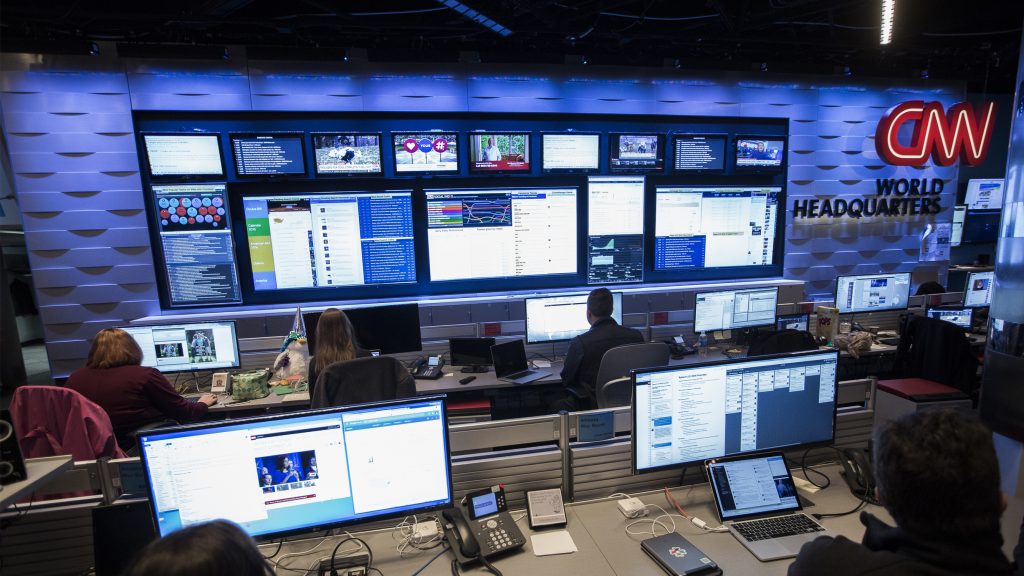The Big Question: Is Print Media on its Way to Becoming Obsolete?
By Newsline Admin | Newsbeat National | Published 8 years ago
Raza Rumi
Raza Rumi is Editor, Daily Times. He also teaches at Cornell Institute for Public Affairs and Ithaca College, USA.
 These are interesting times for journalism as technological advancements are driving the process of how people receive news. Today, the global public has a variety of options through which it can access information. In the last decade, the digital media has expanded and is gradually overtaking newspapers. Journalists, editors and media barons across the globe are wondering what this might spell for the future of print media. One thing is clear: the news business has been disrupted and a centuries-old tradition stands challenged and needs to adapt to imperatives of the digital age.
These are interesting times for journalism as technological advancements are driving the process of how people receive news. Today, the global public has a variety of options through which it can access information. In the last decade, the digital media has expanded and is gradually overtaking newspapers. Journalists, editors and media barons across the globe are wondering what this might spell for the future of print media. One thing is clear: the news business has been disrupted and a centuries-old tradition stands challenged and needs to adapt to imperatives of the digital age.
For instance, in the United States, many newspapers have shelved print editions and gone completely digital. According to a recent report by the PEW Research Center, The New York Times witnessed a 47 per cent annual rise in its digital subscriptions, while the Wall Street Journal saw a 23 per cent rise in digital subscriptions. The overall daily circulation of newspapers in the US declined by 8 per cent in the same period — driven largely by a 10 per cent decline in week-day print circulation. While the larger newspapers are reinventing themselves in the US, Europe and elsewhere, it is the local papers that have been hit the hardest by this transition. One of the key debates in the United States after the 2016 Presidential Election, was the stifling of local news, thereby keeping much of America unaware that Trump’s populism had deeper roots than many assumed.
Similarly, the number of professional journalists has also decreased in many advanced countries. Citizen journalists and bloggers are increasingly replacing reporters as society chooses to produce content for itself. And foreign bureaus are being closed with increased reliance on stringers and new media resources. Yet, the scope of investigative journalism — the hallmark of print media — stays relevant and continues to expand.
People still expect print newspapers to disseminate the truth and be at the forefront of public investigative reporting on current affairs. But the old business model is unworkable. Another example was the shutting down of the print version of the British newspaper The Independent. It has gone digital. This allows for a critical opportunity for the print media to evolve and transform into a newer, hybrid form that caters to consumption trends and technology without compromising on the vitals of journalism — field reporting and human interaction.
Digital media is increasingly setting the news agenda, both globally and somewhat slowly in Pakistan. To survive and retain their audience, the print media will have to drive the news cycle. An investigative story, or a peek into covert decision-making processes splashing on the front page of a newspaper should become the norm for the print industry to retain its historic edge. Some recent examples of print media driving the news cycle are The New York Times and The Washington Post publishing investigative stories about the Trump administration, which have forced Congress and the Justice Department to set up inquiries.
In Pakistan, DAWN published an exclusive investigative story on civil-military tensions on security issues during the fall of 2016. The story triggered a political storm and drove the news cycle for days, while the crisis lingered on for months. This shows that newspapers are and will remain relevant. In South Asia, where the electronic medium has gained ascendancy, the public still needs verified in-depth information that a short-lived TV show cannot provide.
Nearly three months ago, I started my current stint at the Daily Times. It is a huge challenge to frame the newspaper and keep it relevant, given how all the news reaches the public quickly through news channels which function 24/7. It’s a struggle to keep the paper relevant and informative in such an environment. Twitter and Facebook have taken over breaking news as well. Yet, the detailed investigative stories in the past few months have made their impact and influenced debates on TV and social media. All said and done, the shelf life of print is far longer than a soundbyte or a 140 characters-long microblog.
Amir Zia
Amir Zia is the Senior Executive Vice President and Editor English Daily of BOL News.
 The 20-year-old son of my journalist friend hardly reads newspapers, despite being prodded by his father, who has been following this morning ritual religiously, since his teenage years. The boy is simply not interested in the broadsheet. He may pick up a paper once in a blue moon, when his father is angry or insistent, but never out of choice. It is ironic that this youngster does not appreciate the product that his father had been working on for almost three decades.
The 20-year-old son of my journalist friend hardly reads newspapers, despite being prodded by his father, who has been following this morning ritual religiously, since his teenage years. The boy is simply not interested in the broadsheet. He may pick up a paper once in a blue moon, when his father is angry or insistent, but never out of choice. It is ironic that this youngster does not appreciate the product that his father had been working on for almost three decades.
It is not that the boy is averse to reading or uninterested in the world around him, explains the father, “It’s just that the source of information now lies in the palm of his hands — the mobile phone.”
It is mostly through a mobile phone, desktop or laptop, that he communicates with the world and learns about it, he added. That’s what most of his peers also do. This category includes a vast number of Pakistani youths, who go to English-medium private schools and colleges, or have graduated over the past one or two decades or so.
Contrary to their seniors, these Pakistanis — whose age bracket ranges from the late teens to the late 30s, or early 40s — are not hooked up to a particular newspaper or a media group, but they pick and choose, decide what to read and what to ignore, on the basis of trends in their respective social media communities.
This technology-savvy section of society does not believe in submitting to the monopoly of one or two media outlets at a time, when the entire world media remains just a click away. They are globally connected and being bombarded with information from all directions — relevant and irrelevant, authentic and unauthentic, factual and cooked up. Undoubtedly, there is an information and disinformation overload.
After their initial reluctance, the old, traditional media — both print and electronic — has been forced to use the new tools of media to disseminate content — news, features, articles, video clips of programmes and photographs. From the platform of this new media, the traditional content-providers interact directly with users scattered around the globe, rather than confine themselves to just a neighbourhood, town, city, or country.
While the information revolution has magnified the footprints of traditional media outlets, it has also empowered individuals who can upload their content online without the scrutiny of the gatekeepers of information.
So, in the age of this interactive, ever-expanding media, many users are no longer silent consumers of content produced by the conventional media. Instead, they direct and dictate it by building trends on social media and share their own information and opinion on various platforms. The ‘information highway’ is not used merely to promote the content produced by media houses. Users compete with it and even challenge it by generating and disseminating content of their own.
In this aspect, modern Pakistanis follow the global trend, which started in the West, where the circulation of newspapers and magazines is on the decline and in recent years, hundreds of publications have ceased to exist. Does this mean that Pakistan will follow the same trend and witness a shrinking print market?

If we view this from the perspective of modern, globally connected Pakistanis, we will obviously reach this conclusion. This would spell a bleak future for the existing print media publications, which face stiff competition from the electronic as well as the digital media, where revenues are increasing at a much faster pace compared to print, according to industry sources.
However, the print media still retains its number-two position in the overall market share of advertising revenues, estimated at approximately Rs.70 billion to Rs. 75 billion. The electronic media holds the biggest share (around 50 per cent) of advertising revenues. The share of digital media — currently the lowest advertising revenue earner — will continue to rise, as both the media houses and advertisers see its tremendous growth potential. Advertising industry sources say that after registering a handsome double digit growth in 2015-16, there has been a slight drop in overall advertising revenue in the outgoing fiscal year, in which the federal and Punjab governments emerge as the biggest advertisers.
For the print media players, the worrisome challenge is that while they managed to get eyeballs by creating websites and pushing their content on the new media, they have been unable to convert it into a matching revenue stream. Yes, there has been growth in the advertisement revenues of their websites, but it is miniscule as their readers prefer free online content rather than paying for it. Leading media houses face the same challenge in the West, where the penetration of plastic money and online payments is much higher than in developing countries like Pakistan.
In Pakistan’s context, there is another challenge, which the print media faced even before the rise of the information age. The circulation of our publications remains small, owing to the 58 per cent literacy rate in Pakistan’s 200 million-plus population. However, the largest circulated Urdu-language newspaper’s print size is estimated at less than half a million copies and that of the English-language newspaper well below 100,000 copies a day. There are no authentic circulation figures available, given the fact that media owners grossly exaggerate print orders while registering for certification, at the Audit Bureau of Circulation, Pakistan. In comparison, the two largest selling newspapers in the UK — which has a population of 65 million — have a circulation of 1.6 million and 1.5 million copies daily.
The low circulation of newspapers in Pakistan is not solely due to the high cost of newsprint or poor demand. Owners of media houses do not want to push the circulation of their publications beyond a certain limit, to cut costs and maintain higher profits. This strategy may seem to make sense now, but in the long run it is myopic, as eventually, low or depleting circulation would start impacting advertising revenues.
Given the educated Pakistanis’ preference for the digital medium, the low circulation-base of publications and their slow revenue growth, the future of the print media appears bleak. Journalists, such as myself, will probably fall into the category of the last generation of traditional print media dinosaurs — all set to become extinct sooner than later.
But luckily, the print media’s future cannot be summed up simply in black and white.
Let’s take the case of Shakir — an 18-year-old from Sadiqabad, Punjab — who works as a domestic help in the house of the same journalist friend I mentioned, whose son is hooked to digital media and doesn’t read newspapers. Shakir, a school dropout, reads an Urdu-language paper daily, when he gets a little break from work at around 11 am. He skims through the political headlines, but his main interest lies in the news and gossip about actors, movie stars, as well as sports.
We notice countless such Shakirs in the working class and low- and middle-income groups in Pakistan. These young ones and their elders like to romance the printed word whenever they get an opportunity. As the literacy rate is likely to improve (though it declined by 2.0 per cent in 2015-16, under the current democratic dispensation), more working class people, your driver and cook, as well as the chowkidar, electrician and plumber, read various types of publications. They have an appetite for news and information. They would read more, if given the opportunity. This section of Pakistan — much bigger in size — may not be English-language savvy, but it can read and write in Urdu and other provincial languages. It provides the print media with a massive opportunity to expand its circulation and size.
Our demographics, the expected growth in literacy, improvement in economy and purchasing power — all offer the print media a new potential for improving sales.

The New York Time newsroom in 1942
However, the print media must continue to see the rise and rapid expansion of digital media as an advantage, rather than stifling competition. Eventually, publications would be able to carve out a niche for themselves in paid content, rather than offering it for free on the information highway.
Our newsrooms and the outlook of the editorial management must adjust accordingly and they have already begun to do so.
Why doubt the print media’s ability and capacity to adjust and reinvent itself in the face of competition? Wasn’t the rise of commercial radio, in the early 20th century, taken as a death knell for the newspapers? But not only did they survive, they continued to expand. The advent of television in the 1950s, was also seen as a replacement for print; but again it managed to survive, albeit with the demise of afternoon papers in the West. However, some of our local afternoon papers continue to survive — with less fanfare.
The advent of the internet age, after 2000, and the rapid expansion of smartphones in recent years, certainly pose a new kind of challenge for the print media, but it should only help it improve and change for the better. After all, the main trade of print media is not ink, paper or pens, but credible news and information and sound comments and analyses. The medium may change, future publications may look and feel different in the mid to long term, but in every age there will be demand for news, information and its interpretation. So we are not likely to go out of business
Mazhar Abbas
Mazhar Abbas is a Pakistan-based journalist and political analyst.
 Since the ’70s, I have been in the habit of reading newspapers early in the morning. However, over the last few years, much of what is published in the papers has already been covered by TV channels or web-based media.
Since the ’70s, I have been in the habit of reading newspapers early in the morning. However, over the last few years, much of what is published in the papers has already been covered by TV channels or web-based media.
Online news, or web-based content, includes social media, a platform that was given the credit for initiating the Arab Spring, and more recently, for having played a key role in the UK elections. Yet as a source of news, social media is unedited and uncontrollable, as is a great deal of online material
Consequently, the accuracy and credibility of news suffers.
The growing power and accessibility of digital content is undeniable. Today, over 60 per cent of students in Mass Communication departments in campuses across the country are inclined towards the electronic media, mainly because of its glamour. They show little interest in writing or in print media. At the same time, heads of media organisations are spending more money on their TV channels and websites than on their newspapers, as a result of which we are left with few good papers. We no longer see the ‘special supplement’ which carried breaking news, and which, at times, sold more than the paper itself. Salary structure is another driving factor. The total salary package of editors of five leading newspapers is not even 50 per cent of what some anchors draw.
As marketing directors and ratings firms fasten their grips on media across the globe, disinformation is replacing information. The late Zameer Niazi, once summed up the rise of commercialisation and unethical journalism in one word: “presstitution.” He died a few years back, at a time when he was most needed to comment on the power of the media, and its transition from print to electronic mediums and the decline of journalism.
Yet there is a flipside to it all. News updates may reach the readers with unprecedented speed on their smartphones, but this does not mean the information being delivered is verified. This is due to a decrease in editorial control and an increase in priority given to ratings-oriented content. What also jeopardises the quality of web-based content is that it is hurriedly delivered as time is of the essence, whereas this is not necessarily the case in the print media.
Even though digital media is increasingly being turned to as the main source of news, the print media will maintain its position owing to its reliability. The unearthing of the Panama Papers by the International Consortium of Investigative Journalists (ICIJ), is an example of what print media can do.
The rise of unedited online content brings with it the decline of objectivity — a principal central to journalistic ethics and reporting. News is becoming increasingly agenda-driven. As a result, the printed word always has more credibility than any video recording. This was recently confirmed, when a photo of the prime minister’s son, Hussain Nawaz, allegedly appearing before the Joint Investigation Team, was leaked online. The Supreme Court clarified that the video had no legal value.
The power vested in the hands of journalists by social media can, in turn, provide a boost to their written word in print. And although it may appear that, in our society, more importance is being given to photographs and videos, we must remember that in talk shows, discussions have often revolved around how best the media can be salvaged from unethical and immoral practices.
Print media still follows the tradition of clarification, regret and apology, depending on the reaction. TV channels hardly follow this practice unless they receive a notice from PEMRA.
It is the unreliability of online content that will inevitably allow print media to retain its undisputed position as the supplier of verified news.


